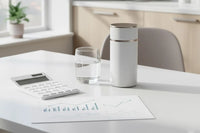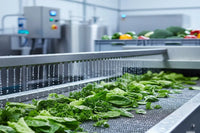Quaternary ammonium compounds—quats—have become a mainstay in food sanitation for decades. They’re in your sanitizer buckets, your spray bottles, your foaming applicators. They’re cheap. They’re available. And they’re starting to fail.
Here’s what many QA directors, sanitation managers, and plant operators are beginning to realize: quats were never designed for high-velocity food production. And they’re quietly costing you compliance, labor hours, equipment longevity, and even shelf life.
If your sanitation SOPs still rely on quat-based disinfectants, this article is your wake-up call.
Because there’s a safer, stronger, and more scalable alternative already in use by USDA facilities, seafood plants, produce packhouses, and even hospital operating rooms. It’s called hypochlorous acid (HOCl)—and it’s the molecule that’s rewriting the rules of food sanitation.
The Hidden Problems with Quats in Food Facilities
Quats may be effective in certain contexts, but in high-throughput production zones, they introduce a dangerous set of compromises. Let’s break it down.
1. Residue Risk
Quats leave behind sticky chemical residues on surfaces and tools. This isn’t just unpleasant—it’s a compliance risk.
- Residue can interfere with microbial swabs
- It may violate zero-tolerance requirements for direct food contact surfaces
- It can impact flavor or product chemistry
- It builds biofilm over time if not properly removed
HOCl, by contrast, evaporates cleanly into water—leaving zero detectable residue on food, surfaces, or equipment.
2. Rinse Requirement
Most quats must be rinsed from any surface that will touch food. In theory, sanitation teams remember. In practice, post-rinse often gets skipped under time pressure. That means:
- Potential chemical contamination of food
- Failed inspections
- Additional water usage
- Longer sanitation cycles
HOCl requires no rinse, even when used on knives, trays, conveyors, or direct product surfaces.
3. Respiratory and Skin Irritation
Quats are known irritants. Even at standard dilution:
- They dry out skin
- Cause rashes or dermatitis
- Trigger respiratory irritation during fogging or spray application
- Require gloves and PPE
For workers exposed daily—especially in enclosed spaces—this becomes a silent health burden. Morale drops. Absenteeism rises. Complaints start piling up.
HOCl is skin-safe, eye-safe, and non-toxic. It’s used in wound care, dentistry, and even ophthalmology. You can fog it into occupied rooms with no PPE and no re-entry delay.
4. Antimicrobial Resistance
Over time, overuse of quats can lead to adaptive resistance in microbial populations. In fact, studies have shown that certain bacteria—Listeria monocytogenes among them—can:
- Develop reduced susceptibility to quats
- Form quat-resistant biofilms
- Become harder to remove in facilities that sanitize exclusively with quats
HOCl doesn’t contribute to antimicrobial resistance. It kills through oxidation, not enzymatic targeting—meaning pathogens cannot adapt.
5. Corrosion and Equipment Degradation
Quats break down seals, gaskets, soft plastics, and even metal fixtures over time—especially when applied hot or left unneutralized.
- Cracking belts
- Discolored pipes
- Seal failures on pumps and tanks
HOCl is non-corrosive at standard concentrations, even to 304/316 stainless and food-safe plastics. You can spray or fog it directly onto sensitive machinery.
Why Facilities Are Replacing Quats with HOCl
HOCl provides all the sanitation power of quats—without the side effects. It is:
- ✅ EPA-approved for food contact surfaces (List K)
- ✅ FDA GRAS for direct food application
- ✅ USDA Organic compliant
- ✅ NSF D2 certified (no-rinse)
- ✅ Safe for daily use, even in enclosed areas
And HOCl works across your entire facility:
- Surface disinfection
- Tool and tray dips
- Fogging sanitation
- Hand sanitizing stations
- Conveyor spray lines
- RTE zone cleaning
Where quats complicate your protocol, HOCl simplifies it.
Side-by-Side Comparison: HOCl vs Quats
| Feature | HOCl | Quats |
|---|---|---|
| Kill Power | 99.999%+ | 99.9%–99.99% |
| Rinse Required | No | Yes (on food contact surfaces) |
| Residue | None | Sticky residue |
| PPE Required | No | Yes |
| Toxicity | Non-toxic | Irritant, potential allergen |
| Worker Safety | Safe for skin, eyes, lungs | Gloves and goggles required |
| Resistance Potential | None | Yes (long-term adaptation) |
| Use in Occupied Areas | Yes | Typically discouraged |
| Organic Approval | Yes (NOP compliant) | No |
Real Facilities Making the Switch
-
🧼 Bakery in Pennsylvania
Problem: Gloves becoming brittle due to quat exposure. Failed a BRC audit due to residue.
Solution: Switched to HOCl surface fogging and hand dip stations.
Result:- No more PPE complaints
- Faster sanitation cycles
- Passed next BRC audit with zero CAPAs
-
🥬 Salad Processor in Texas
Problem: Quat residues on trays interfering with Listeria swab results. Staff complained of skin rashes.
Solution: Installed EcoloxTech HOCl generator. Replaced quat sanitizer buckets.
Result:- Swab scores improved dramatically
- No need for rinse water
- Reduced sanitizer chemical cost by 32%
-
🐟 Seafood Packer in Washington
Problem: Biofilm forming in dip tanks. Belts showing early corrosion. Distributors returning product due to off-odor.
Solution: Replaced quat-based sanitizing system with HOCl foggers and direct spray units.
Result:- Biofilm eliminated in 3 weeks
- Product shelf life extended by 3 days
- Equipment degradation stopped
Final Word: Upgrade the Molecule. Upgrade the Facility.
Quats had their moment. But in modern food safety, residue, rinse time, irritation, and resistance are luxuries no processor can afford.
HOCl is the next generation.
- Safe
- Simple
- Fast
- Audit-ready
- Worker-friendly
- Zero-residue
- Rinse-free
And unlike quats, your pathogens won’t adapt.
Ready to Make the Switch?
📩 Download the HOCl Sanitation Blueprint, including:
- Quat vs HOCl comparison charts
- Audit-ready compliance documents
- Cost savings + ROI forecast
- PPM usage guide for each sanitation application
- Full SSOP templates and swab improvement protocols





